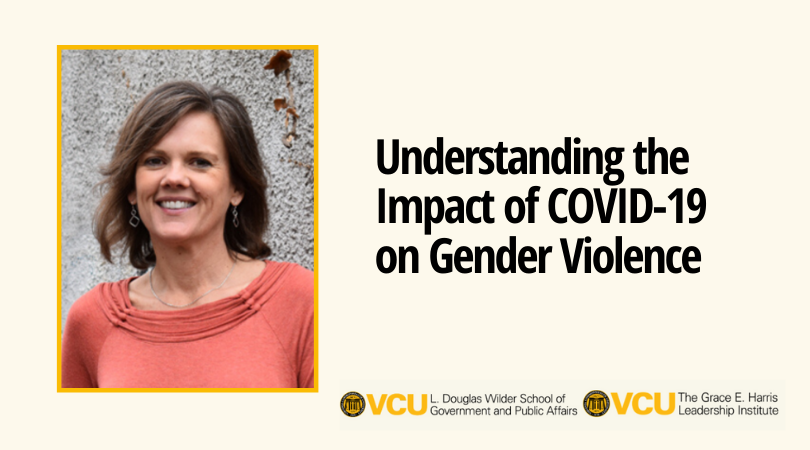News
Understanding the Impact of COVID-19 on Gender Violence

By Briana Williams
April 28, 2020
Early evidence suggests that quarantine measures imposed as a response to the COVID-19 pandemic are putting women and children at heightened risk of violence in the home and cutting them off from essential protection services and social networks, said Wilder School Professor Sarah Jane Brubaker.
Brubaker’s observations were the subject of "Impacts of COVID-19 on Intimate Partner Violence and Victimization," a virtual discussion co-hosted by the Grace E. Harris Leadership Institute and Minority Political Leadership Institute at the Center for Public Policy on April 24.
“For women who are being constantly watched, especially during this time, it can often be challenging to get information to people without alerting the abuser,” Brubaker said.
Brubaker, who directs the Wilder School’s mics and highlighted that during health crises, women typically take on additional physical, psychological and time burdens as caregivers. She also discussed various direct and indirect pathways linking pandemics to violence against women and children.
“There are many factors that connect COVID-19 and abuse,” she said. “Victims are facing stress, isolation and separation from support systems such as families who are immuno-compromised or live far away, co-workers, social services, law enforcement, counselors, teachers and shelters.”
Child abuse is also increasing, especially for children who are isolated from individuals who typically may care for them on a daily basis. Children are spending much more time online and are at a higher risk of higher risk of grooming, sexual exploitation, cyberbullying and other online threats.
“Daily routines being disrupted and children need routine and structure. Many are afraid and unable to process their emotions right now. Not to mention, parents are overwhelmed.”
Groups of children who are especially vulnerable to abuse:
- LGBTQA + youth
- Children with disabilities
- Children who are homeless
- Children who are incarcerated
The increase of intimate partner violence can be seen in both common couple violence where both individuals engage in violence as conflict management and coercive control violence, in which one abuser exercises control over one victim through violence, tactics and threats.
“During this time, abusers can try to keep partners away from family, help, and other services,” noted Brubaker. “Abusers want victims to be completely reliant on them for everything to further manipulate them.”
Any impactful policy or programmatic response to gender violence will need to multifaceted, said Brubaker.
“We need to focus on a system level approach when thinking about some actionable things we can do, such as making sure people who are able to get this information to first respondents,” stated Brubaker.
Additionally, she suggested expanding and reinforcing social safety nets, shelter and temporary housing for survivors, as well as integrating violence against women and children programming into longer-term pandemic preparedness.
“Now is the time to come up with creative ways to get resources and help to people who need them,” said Brubaker.
Looking for resources and support?
Visit, Virginia Sexual and Domestic Violence Action Alliance for tools designed for workers to use and recognize abusers.